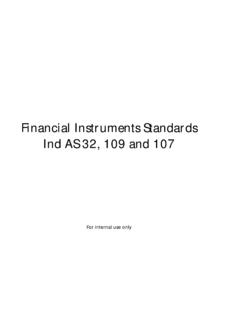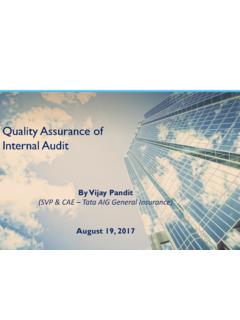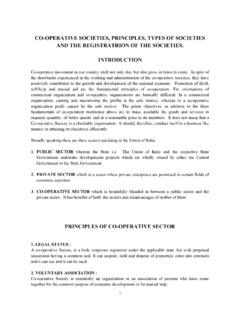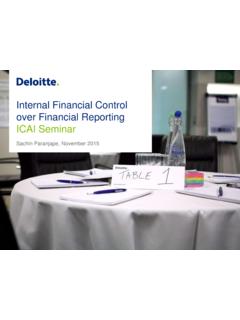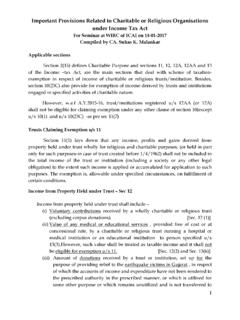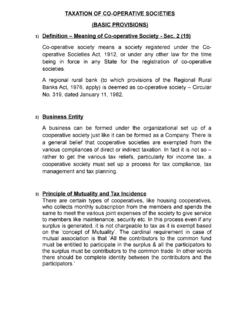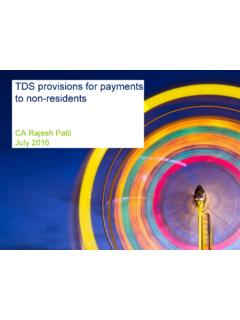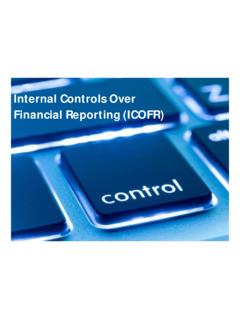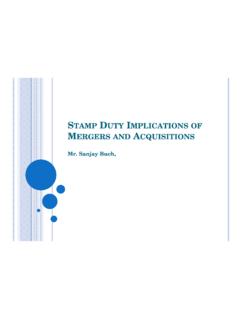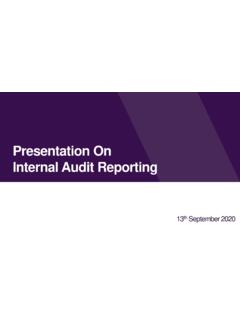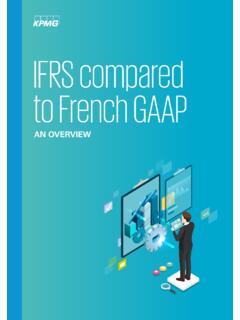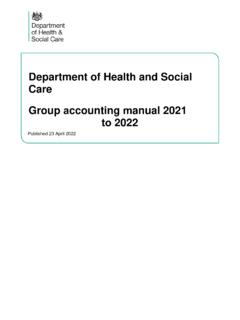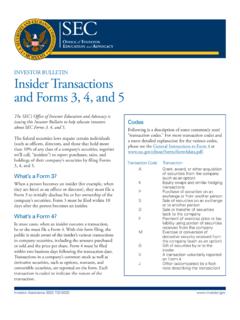Transcription of Implementation of IND AS – Impact on Corporate Tax
1 Of IND AS Impact on Corporate TaxCA Dinesh Patil16 November 201922 AgendaIntroduction, Features and RoadmapComponents of Financial StatementsLiability and AssetsInventoriesImpact on income-taxProvisions, Contingent Liabilities and Contingent AssetsKey take-aways33 Introduction, Features and Roadmap44 Indian accounting Standards (Ind AS)VsIFRS AdoptionImplementing in exact form as issued by International accounting Standards Board (IASB)IFRS CovergenceImplementing IFRS with certain departures to suit the countryCompanies (Indian accounting Standard rules ), 2015 Ind AS India perspectiveIFRSC arve-outsIND-ASHas carve outs and carve ins as compared to IFRSNew standard on revenue recognition incorporated55 Salient features of IFRS converged Ind ASPrinciple-based StandardsMore importance to concept of substance over form Reliance on fair valuation, and measurements on time value of moneyRequire more disclosures of all relevant information and assumptionsRequire higher degree of judgment and estimatesRestatement of previously issued Financial statements66 Roadmap of Implementation of Ind AS in IndiaPHASE IIPHASE IMANDATORY Implementation OF IND-ASAccounting period beginning from 1 April 2016 with comparatives for March 2016 Once Ind AS is followed.
2 It should be followed for all subsequent yearsVOLUNTARY IMPLEMENTATIONKEY MATTERSA ccounting period beginning from 1 April 2017 with comparatives for March 2017 Listed Companies or Companies in the process of Listing and having net worth of INR 500 Crores or more (debt or equity, In or outside India listing) All other unlisted Companies having net worth of INR 500 Crores or more Holding, Subsidiary, Joint venture or Associates of companies covered above Listed Companies or Companies in the process of Listing and having net worth of less than INR 500 Crores or more (debt or equity, In or outside India listing) All other unlisted Companies having net worth of INR 250 Crores or more but less than INR 500 Crores Holding, Subsidiary, Joint venture or Associates of companies covered aboveAny company can voluntarily adopt Ind AS from year beginning 1 April 2015 with comparative for 2014-15 Companies listed in SMEs need not follow Ind ASSeparate roadmap for Banks, Insurance Companies and NBFCs77 Components of Financial Statements88 Components of IND-AS Financial StatementsFinancial StatementsNotes comprising summary of significant accounting policies and other explanatory information Balance sheet at the end of the periodStatement of profit and loss for the period (including Other Comprehensive income OCI )
3 Statement of changes in equity for the period Statement of cash flows for the period Comparative information in respect of the preceding period99 Format of Statement of Profit & Loss AccountStatement of Profit and Loss accountCurrent PeriodPrevious periodRevenueRevenue from OperationsOther incomeTotal Income from operationsExpensesCost of Materials consumedExcise dutyPurchase of stock-in-tradeChanges in inventories of finished goods, stock-in-trade and work-in-progressEmployee Benefit expensesFinance costDepreciation and Amortization expensesOther expensesTotal Expenses1010 Format of Statement of Profit & Loss AccountStatement of Profit and Loss accountCurrent PeriodPrevious periodProfit before taxTax expense(i) Current tax(ii) Deferred taxProfit (Loss) for the period from continuing operationsProfit/(loss) from discontinued operationsTax expense of discontinued operationsProfit/(loss) from Discontinued operations(after tax)Profit/(loss) for the periodOther comprehensive IncomeA.
4 (i) Items that will not be reclassified to profit or loss (revaluation, re-measurement of defined benefit plan etc.)(ii) Income tax relating to items that will not be reclassified to profit or lossB. (i) Items that will be reclassified to profit or loss (exchange difference in translation of financial statement of foreign operations)(ii) Income tax relating to items that will be reclassified to profit or lossTotal comprehensive income for the period1111 Impact on income-tax1212 International view on Impact of IFRS on tax computationUKBrazilNether-landsKoreaTaxa ble profit is principally based on the legal entity s statutory accounts, with adjustments in local tax law Separate tax legislation that deals with IFRS conversion Computation of income is prepared based on domestic tax laws and IFRS adjustments are ignored IFRS adjustments are to be ignored Tax computation governed by local tax laws Annual accounts is prepared on the basis of Dutch GAAP.
5 Tax return is based on these financials and taking into account business principles Tax rules are largely based on GAAP. As the number of differences between IFRS and GAAP increase, the number of adjustments required increases1313 Tax Impact calculations - reliance on books of accountsComputation of cost of undertaking under slump saleImpact on disallowance under section 14 ATransfer pricing - determination of ALP, comparability, on interest deduction paid or payable to AEAscertaining fair market value for the purpose of taxability under section 56(2)(x) / 50 CAProperties/ Liabilities are transferred at books values in case of demergerDetermination of accumulated profits for the purpose of deemed dividends Forms basis of book profits for MAT taxation1414 Interplay between Ind AS and Income TaxAccounting under Ind ASImpact on MATG uidance under section 115JB and FAQS pecific adjustment as prescribed to be madeImpact under normal provision of Income tax ActTreatment covered under ICDS* or ActFollow treatment as per ICDS or Act or Binding Judicial precedentsTreatment neither covered by ICDS nor ActInterpret using Judicial precedentsGiven statutory recognition from AY 2017-181515 Interplay between Ind AS and Income TaxKey Principles for computing taxable
6 Income : Business income is computed in accordance with the method of accounting regularly employed by thetaxpayer could be either cash or mercantile / accrual Business income as per method of accounting adopted to be adjusted by the specific deductions /allowances / disallowances specified in the Act Real income is taxable and not hypothetical income unrealized gains / losses not recognized for tax computation Concept of time value of money not recognized Notional expenses not allowable. However, provisions are allowed if created on a scientific basis Adjustments to be made to accounting profits as per notified Income Computation and Disclosure Standards(ICDS) - effective from FY 2016-17 Profits as computed following Ind AS to be the starting point for computing taxable income and further adjusted in the light of principles stated above1616 Impact on Income tax Specific Ind ASAssets & LiabilitiesIncome and expenseFinancial Liability and Assets: Ind AS 32, Ind AS 109, Ind AS 107 & Ind AS 113 Inventories Ind-AS 2 Provisions, Contingent Liabilities and Contingent Assets.
7 Ind AS 37 The Effect of Changes in Foreign Exchange Rates Ind-AS 21 Borrowing cost Ind-AS 23 Property, Plant, Equipment s (IND AS 16) Government Grants (IND AS 20)MAT ImpactRevenue recognition - IND AS 115 Intangible Assets (IND AS 38)1717 Financial Liability and Assets: Ind AS 32, Ind AS 109, Ind AS 107 & Ind AS 1131818 Overview of the FI standards -Ind AS 32, 109, Ind AS 107 & Ind AS 113 Fair value measurements- Ind AS 113 Recognition and derecognitionClassification & MeasurementDerivativesHedge accountingInd AS 109- Financial Instruments Liability and asset classificationInd AS 32: FI: PresentationDisclosuresInd AS 107: FI: Disclosures1919 Financial Instrument - DefinitionA financial asset of one entityA financial liability or equity of another entity Any Contract that gives rise to 2020 Liability or equity: Classification per Ind AS 32 LiabilityEquityContractual obligation to deliver cash or another financial asset or exchange financial assets/liabilities under potentially unfavourable conditionsResidual interest in the assets of the enterprise after deducting its liabilities Substance over form2121 Preference shares financial liability or equity?
8 Preference shares to be classified as a financial liability if all the following conditions are met: they are redeemable on a specific date they are redeemable at the option of the holder Issuer obligated to make payments in form of interest or dividendRelated dividend will appear above the line in the profit and loss account2222 Substance over form or legal structure?Substance over FormAccounts and the accounting method followed by an assessee continuously for a given period of time needs to be presumed to be correct till the AO comes to the conclusion for reasons to be given that the system does not reflect true and correct profits;CIT vs. Woodward Governor (Supreme Court)Legal FormThe true effect of accretion made pursuant to the contract has to be judged not by artificial rules but from the intention of the parties to the of Andhra Pradesh v.
9 Kone Elevators India PVt. Ltd (Supreme Court)Two exceptions are noted for recharacterisation for transaction where (i) where the economic substance of a transaction differs from its form and (ii) where the form and substance of the transaction are the same but arrangements made in relation to the transaction, viewed in their totality, differ from those which would have been adopted by independent enterprises behaving in a commercially rational Appliances Ltd (Delhi High Court)2323 Convertible loans expense dividend or interest?Finnish Supreme Court The taxpayer was a Finnish company (FI Co) which was owned by a company resident in Luxembourg (LU Co). In 2009, FI Co received a loan of EUR 15 million from LU Co and wanted to deduct EUR 1,337,500 as interest expenses paid to LU Co.
10 The loan was given without any collateral and did not have any provisions for repayment by a definite date. The interest rate was fixed at 30% and the interest was added to the principal. The loan could be paid back only upon FI Co's request and was under IFRS accounting rules treated as equity (hybrid loan). The Finnish tax authorities recharacterized the loan as equity investment and consequently, disallowed the interest deduction. IssueWhether the loan could be re-characterized as equity investment and, consequently, the interest paid for such loan could be disallowed. 2424 Amortised cost and effective interest methodAmortised cost is calculated using the effective interest rate methodInitial recognition amountAmortised cost Cash receivedInterest income / expenseImpairment=-/+--Example1.
